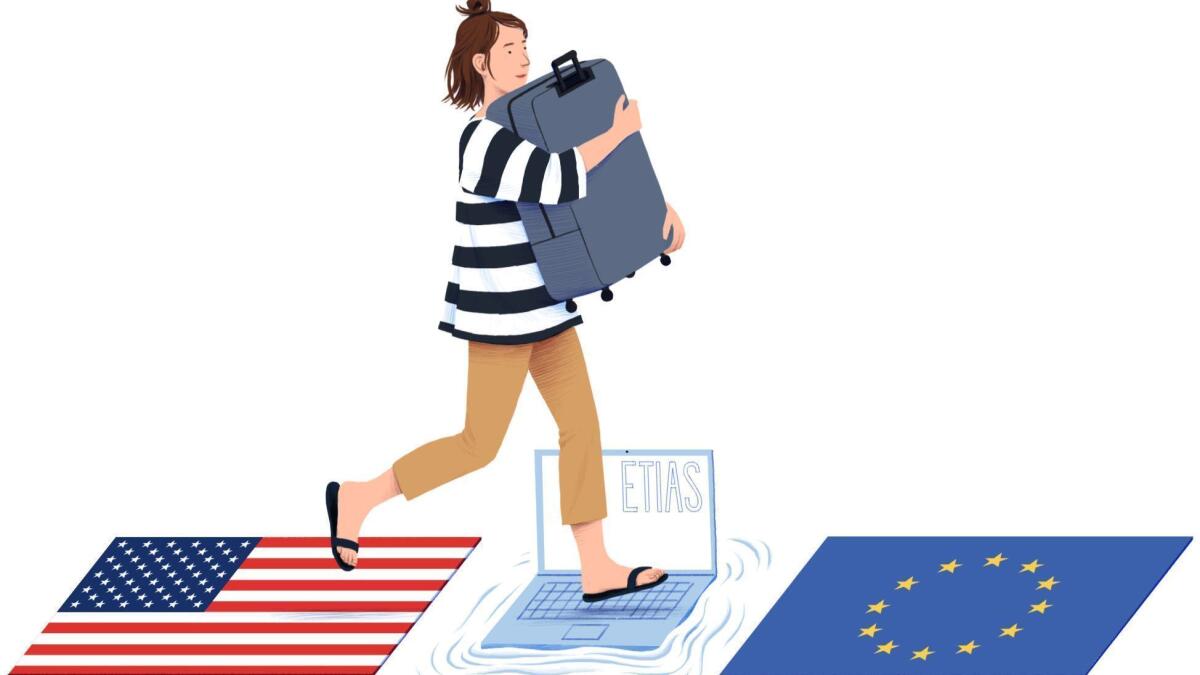What you need to know about the authorization you’ll need to visit Europe

- Share via
U.S. travelers can move easily from country to country, for the most part. For instance, if you want to go to France next weekend, you get on a plane and go to France.
But beginning in 2021, you’ll need preauthorization to visit certain European countries, including France, the European Union recently announced.
Please do not call this authorization a “visa.” It is not a visa, which Webster’s New World College Dictionary describes as “an endorsement on a passport, showing that a person has been granted official entry.”
If you have visited China, Russia or India, for instance, you’ve had to jump through hoops (or you have hired a company to do so on your behalf) to get that official visa. You may need to make an in-person visit to an embassy or consulate, although increasingly electronic visas are being used.
For many visa processes, you may need another photo or two, and you may have to fork over some money. The cost varies by country.
To find out whether the country you’re planning to visit requires a visa, go to country information at the State Department’s website. It will direct you, in most cases, to the proper channels through which you can apply.
Confusion arose when several organizations reported that the EU would make visitors get a visa for countries that were previously visa-free. Wrong.
What the European Union is asking for is not nearly as cumbersome because it is not a visa, it has emphasized repeatedly. And, said Maria Belovas, a representative for the EU delegation in Washington, D.C., the permission will cost less than most visas (about 7 euros, or about $8), can be done online and will take considerably less time.
It’s called ETIAS, or European Travel Information and Authorization System, and essentially it is another border security check.
It is, Belovas said, similar to U.S. Customs and Border Protection’s Electronic System for Travel Authorization, which describes itself as a “system that determines the eligibility of visitors to travel to the United States under the Visa Waiver Program.” It allows citizens from 38 countries to travel to the U.S. without a visa.
The EU’s ETIAS was “created to identify any security or irregular migratory risks posed by visa-exempt visitors traveling to the Schengen area,” an EU news release noted.
The U.S. State Department describes the Schengen area as encompassing “26 European countries, where internal border checks have largely been abolished for short-term tourism, a business trip, or transit to a non-Schengen destination.”
The 26 Schengen countries: Austria; Belgium; Czech Republic; Denmark; Estonia; Finland; France; Germany; Greece; Hungary; Iceland; Italy; Latvia; Liechtenstein; Lithuania; Luxembourg; Malta; Netherlands; Norway; Poland; Portugal; Slovakia; Slovenia; Spain; Sweden; and Switzerland.
You’ll see quite a few tourist favorites, which means you’ll need to get the authorization to visit. It will be valid for three years.
About 95% of applicants will be automatically cleared to enter, the EU release said. An additional 3% to 4% will receive a positive decision after information is verified. If you are still rejected, you may appeal.
Not all details have been worked out, Belovas said. “The main message is don’t worry — it’s 2019,” she said. “Everyone who needs to be aware will be aware.”
To learn more, go to the ETIAS page, where a short video explains more.
A South American country makes a change
For those who have struggled with Brazil’s visa system (and yes, it is a visa), here’s some good news: Brazil will drop its visa requirement after June 16. You will need the visa before then, but afterward, it’s no longer necessary.
Brazil used to charge $160 for a visa, and it was not always easy to navigate the system. Last year, it introduced an e-visa, and the cost dropped to $40, plus a $4.24 service charge.
Beginning June 17, you will be free of the requirement, Brazil Tourism said.
If you are traveling before that June 17 deadline, you can apply for the e-visa at Brazil.VSFevisa.com.
Have a travel problem, question or dilemma? Write to travel@latimes.com. We regret we cannot answer every inquiry.
More to Read
Sign up for The Wild
We’ll help you find the best places to hike, bike and run, as well as the perfect silent spots for meditation and yoga.
You may occasionally receive promotional content from the Los Angeles Times.







